Activated sludge
The activated sludge process is a type of biological wastewater treatment process for treating sewage or industrial wastewaters using aeration and a biological floc composed of bacteria and protozoa. It uses air (or oxygen) and microorganisms to biologically oxidize organic pollutants, producing a waste sludge (or floc) containing the oxidized material.
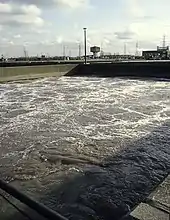
The activated sludge process for removing carbonaceous pollution begins with an aeration tank where air (or oxygen) is injected into the waste water. This is followed by a settling tank to allow the biological flocs (the sludge blanket) to settle, thus separating the biological sludge from the clear treated water. Part of the waste sludge is recycled to the aeration tank and the remaining waste sludge is removed for further treatment and ultimate disposal.
Plant types include package plants, oxidation ditch, deep shaft/vertical treatment, surface-aerated basins, sequencing batch reactors (SBRs). Aeration methods include diffused aeration, surface aerators (cones) or, rarely, pure oxygen aeration.
Sludge bulking can occur which makes activated sludge difficult to settle and frequently has an adverse impact on final effluent quality. Treating sludge bulking and managing the plant to avoid a recurrence requires skilled management and may require full-time staffing of a works to allow immediate intervention.[1] A new development of the activated sludge process is the Nereda process which produces a granular sludge that settles very well.[2] [3]
Purpose
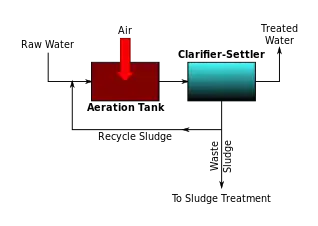
.jpg.webp)
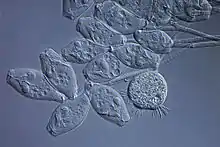
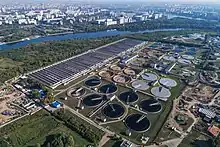
The activated sludge process is a biological process used to oxidise carbonaceous biological matter, oxidising nitrogenous matter (mainly ammonium and nitrogen) in biological matter, and removing nutrients (nitrogen and phosphorus).
Process description
The process takes advantage of aerobic micro-organisms that can digest organic matter in sewage, and clump together (by flocculation) as they do so. It thereby produces a liquid that is relatively free from suspended solids and organic material, and flocculated particles that will readily settle out and can be removed.[4]
The general arrangement of an activated sludge process for removing carbonaceous pollution includes the following items:
- Aeration tank where air (or oxygen) is injected in the mixed liquor.
- Settling tank (usually referred to as "final clarifier" or "secondary settling tank") to allow the biological flocs (the sludge blanket) to settle, thus separating the biological sludge from the clear treated water.
Treatment of nitrogenous matter or phosphate involves additional steps where the processes are managed to generate an anoxic zone so that phosphates can be solubilised in the reducing environment and oxides of nitrogen can be reduced to ammonium ion.
Bioreactor and final clarifier
The process involves air or oxygen being introduced into a mixture of screened, and primary treated sewage or industrial wastewater (wastewater) combined with organisms to develop a biological floc which reduces the organic content of the sewage. This material, which in healthy sludge is a brown floc, is largely composed of Saprotrophic bacteria but also has an important protozoan flora component mainly composed of amoebae, Spirotrichs, Peritrichs including Vorticellids and a range of other filter-feeding species. Other important constituents include motile and sedentary Rotifers. In poorly managed activated sludge, a range of mucilaginous filamentous bacteria can develop - including Sphaerotilus natans, Gordonia,[5] and other microorganisms - which produces a sludge that is difficult to settle and can result in the sludge blanket decanting over the weirs in the settlement tank to severely contaminate the final effluent quality. This material is often described as sewage fungus but true fungal communities are relatively uncommon.
The combination of wastewater and biological mass is commonly known as mixed liquor. In all activated sludge plants, once the wastewater has received sufficient treatment, excess mixed liquor is discharged into settling tanks and the treated supernatant is run off to undergo further treatment before discharge. Part of the settled material, the sludge, is returned to the head of the aeration system to re-seed the new wastewater entering the tank. This fraction of the floc is called return activated sludge (R.A.S.).
The space required for a sewage treatment plant can be reduced by using a membrane bioreactor to remove some wastewater from the mixed liquor prior to treatment. This results in a more concentrated waste product that can then be treated using the activated sludge process.
Many sewage treatment plants use axial flow pumps to transfer nitrified mixed liquor from the aeration zone to the anoxic zone for denitrification. These pumps are often referred to as internal mixed liquor recycle pumps (IMLR pumps). The raw sewage, the RAS, and the nitrified mixed liquor are mixed by submersible mixers in the anoxic zones in order to achieve denitrification.
Sludge production
Activated sludge is also the name given to the active biological material produced by activated sludge plants. Excess sludge is called "surplus activated sludge" or "waste activated sludge" and is removed from the treatment process to keep the ratio of biomass to food supplied in the wastewater in balance. This sewage sludge is usually mixed with primary sludge from the primary clarifiers and undergoes further sludge treatment for example by anaerobic digestion, followed by thickening, dewatering, composting and land application.
The amount of sewage sludge produced from the activated sludge process is directly proportional to the amount of wastewater treated. The total sludge production consists of the sum of primary sludge from the primary sedimentation tanks as well as waste activated sludge from the bioreactors. The activated sludge process produces about 70–100 grams per cubic metre (1.9–2.7 oz/cu yd) of waste activated sludge (that is grams of dry solids produced per cubic metre of wastewater treated). 80 grams per cubic metre (2.2 oz/cu yd) is regarded as being typical.[6] In addition, about 110–170 grams per cubic metre (3.0–4.6 oz/cu yd) of primary sludge is produced in the primary sedimentation tanks which most - but not all - of the activated sludge process configurations use.[6]
Process control
The general process control method is to monitor sludge blanket level, SVI (Sludge Volume Index), MCRT (Mean Cell Residence Time), F/M (Food to Microorganism), as well as the biota of the activated sludge and the major nutrients DO (Dissolved oxygen), nitrogen, phosphate, BOD (Biochemical oxygen demand), and COD (Chemical oxygen demand). In the reactor/aerator and clarifier system, the sludge blanket is measured from the bottom of the clarifier to the level of settled solids in the clarifier's water column; this, in large plants, can be done up to three times a day.
The SVI is the volume of settled sludge occupied by a given mass of dry sludge solids. It is calculated by dividing the volume of settled sludge in a mixed liquor sample, measured in milliliters per liter of sample (after 30 minutes of settling), by the MLSS (Mixed Liquor Suspended Solids), measured in grams per liter.[7][8] The MCRT is the total mass (in kilograms or pounds) of mixed liquor suspended solids in the aerator and clarifier divided by the mass flow rate (in kilograms/pounds per day) of mixed liquor suspended solids leaving as WAS and final effluent.[7][8] The F/M is the ratio of food fed to the microorganisms each day to the mass of microorganisms held under aeration. Specifically, it is the amount of BOD fed to the aerator (in kilograms/pounds per day) divided by the amount (in kilograms or pounds) of Mixed Liquor Volatile Suspended Solids (MLVSS) under aeration. Note: Some references use MLSS (Mixed Liquor Suspended Solids) for expedience, but MLVSS is considered more accurate for the measure of microorganisms.[7][8] Again, due to expedience, COD is generally used, in lieu of BOD, as BOD takes five days for results.
Based on these control methods, the amount of settled solids in the mixed liquor can be varied by wasting activated sludge (WAS) or returning activated sludge (RAS).
Plant types
There are a variety of types of activated sludge plants.[9] These include:
Package plants
There are a wide range of types of package plants, often serving small communities or industrial plants that may use hybrid treatment processes often involving the use of aerobic sludge to treat the incoming sewage. In such plants the primary settlement stage of treatment may be omitted. In these plants, a biotic floc is created which provides the required substrate. Package plants are designed and fabricated by specialty engineering firms in dimensions that allow for their transportation to the job site in public highways, typically width and height of 3.7 by 3.7 metres (12 ft × 12 ft). Length varies with capacity with larger plants being fabricated in pieces and welded on site. Steel is preferred over synthetic materials (e.g., plastic) for its durability. Package plants are commonly variants of extended aeration, to promote the "fit and forget" approach required for small communities without dedicated operational staff. There are various standards to assist with their design.[10][11][12]
To use less space, treat difficult waste, and intermittent flows, a number of designs of hybrid treatment plants have been produced. Such plants often combine at least two stages of the three main treatment stages into one combined stage. In the UK, where a large number of wastewater treatment plants serve small populations, package plants are a viable alternative to building a large structure for each process stage. In the US, package plants are typically used in rural areas, highway rest stops and trailer parks.[13]
Package plants may be referred to as high charged or low charged. This refers to the way the biological load is processed. In high charged systems, the biological stage is presented with a high organic load and the combined floc and organic material is then oxygenated for a few hours before being charged again with a new load. In the low charged system the biological stage contains a low organic load and is combined with flocculate for longer times.
Oxidation ditch
In some areas, where more land is available, sewage is treated in large round or oval ditches with one or more horizontal aerators typically called brush or disc aerators which drive the mixed liquor around the ditch and provide aeration.[9] These are oxidation ditches, often referred to by manufacturer's trade names such as Pasveer, Orbal, or Carrousel. They have the advantage that they are relatively easy to maintain and are resilient to shock loads that often occur in smaller communities (i.e. at breakfast time and in the evening).
Oxidation ditches are installed commonly as 'fit & forget' technology, with typical design parameters of a hydraulic retention time of 24 – 48 hours, and a sludge age of 12 – 20 days. This compares with nitrifying activated sludge plants having a retention time of 8 hours, and a sludge age of 8 – 12 days.
Deep shaft / Vertical treatment
Where land is in short supply sewage may be treated by injection of oxygen into a pressured return sludge stream which is injected into the base of a deep columnar tank buried in the ground. Such shafts may be up to 100 metres (330 ft) deep and are filled with sewage liquor. As the sewage rises the oxygen forced into solution by the pressure at the base of the shaft breaks out as molecular oxygen providing a highly efficient source of oxygen for the activated sludge biota. The rising oxygen and injected return sludge provide the physical mechanism for mixing of the sewage and sludge. Mixed sludge and sewage is decanted at the surface and separated into supernatant and sludge components. The efficiency of deep shaft treatment can be high.
Surface aerators are commonly quoted as having an aeration efficiency of 0.5–1.5 kg O2/kWh (1.1–3.3 lb O2/kWh), diffused aeration as 1.5–2.5 kg O2/kWh (3.3–5.5 lb O2/kWh). Deep Shaft claims 5–8 kg O2/kWh (11–18 lb O2/kWh).
However, the costs of construction are high. Deep Shaft has seen the greatest uptake in Japan,[14] because of the land area issues. Deep Shaft was developed by ICI, as a spin-off from their Pruteen process. In the UK it is found at three sites: Tilbury, Anglian water, treating a wastewater with a high industrial contribution;[15] Southport, United Utilities, because of land space issues; and Billingham, ICI, again treating industrial effluent, and built (after the Tilbury shafts) by ICI to help the agent sell more.
DeepShaft is a patented, licensed, process. The licensee has changed several times and currently (2015) Noram Engineering[16] sells it.
Surface-aerated basins
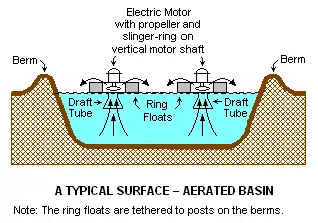
Most biological oxidation processes for treating industrial wastewaters have in common the use of oxygen (or air) and microbial action. Surface-aerated basins achieve 80 to 90% removal of BOD with retention times of 1 to 10 days.[17] The basins may range in depth from 1.5 to 5.0 metres (4.9 to 16.4 ft) and utilize motor-driven aerators floating on the surface of the wastewater.[17]
In an aerated basin system, the aerators provide two functions: they transfer air into the basins required by the biological oxidation reactions, and they provide the mixing required for dispersing the air and for contacting the reactants (that is, oxygen, wastewater and microbes). Typically, the floating surface aerators are rated to deliver the amount of air equivalent to 1.8 to 2.7 kilograms O2/kWh (4.0 to 6.0 lb O2/kWh). However, they do not provide as good mixing as is normally achieved in activated sludge systems and therefore aerated basins do not achieve the same performance level as activated sludge units.[17]
Biological oxidation processes are sensitive to temperature and, between 0 and 40 °C (32 and 104 °F), the rate of biological reactions increase with temperature. Most surface aerated vessels operate at between 4 and 32 °C (39 and 90 °F).[17]
Sequencing batch reactors (SBRs)
Sequencing batch reactors (SBRs) treat wastewater in batches within the same vessel. This means that the bioreactor and final clarifier are not separated in space but in a timed sequence. The installation consists of at least two identically equipped tanks with a common inlet, which can be alternated between them. While one tank is in settle/decant mode the other is aerating and filling.
Aeration methods
Diffused aeration
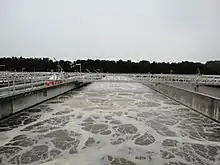
Sewage liquor is run into deep tanks with diffuser grid aeration systems that are attached to the floor. These are like the diffused airstone used in tropical fish tanks but on a much larger scale. Air is pumped through the blocks and the curtain of bubbles formed both oxygenates the liquor and also provides the necessary mixing action. Where capacity is limited or the sewage is unusually strong or difficult to treat, oxygen may be used instead of air. Typically, the air is generated by some type of air blower.
Surface aerators (cones)

Vertically mounted tubes of up to 1-metre (3.3 ft) diameter extending from just above the base of a deep concrete tank to just below the surface of the sewage liquor. A typical shaft might be 10 metres (33 ft) high. At the surface end, the tube is formed into a cone with helical vanes attached to the inner surface. When the tube is rotated, the vanes spin liquor up and out of the cones drawing new sewage liquor from the base of the tank. In many works, each cone is located in a separate cell that can be isolated from the remaining cells if required for maintenance. Some works may have two cones to a cell and some large works may have 4 cones per cell.
Pure oxygen aeration
Pure oxygen activated sludge aeration systems are sealed-tank reactor vessels with surface aerator type impellers mounted within the tanks at the oxygen carbon liquor surface interface. The amount of oxygen entrainment, or DO (Dissolved Oxygen), can be controlled by a weir adjusted level control, and a vent gas oxygen controlled oxygen feed valve. Oxygen is generated on site by cryogenic distillation of air, pressure swing adsorption, or other methods. These systems are used where wastewater plant space is at a premium and high sewage throughput is required as high energy costs are involved in purifying oxygen.
Recent developments
A new development of the activated sludge process is the Nereda process which produces a granular sludge that settles very well (the sludge volume index is reduced from 200–300 to 40 millilitres per gram (192–288 to 38 US fl oz/oz)). A new process reactor system is created to take advantage of this quick settling sludge and is integrated into the aeration tank instead of having a separate unit outside.[2] About 30 Nereda wastewater treatment plants worldwide are operational, under construction or under design, varying in size from 5,000 up to 858,000 person equivalent.[3]
Issues
Process upsets
Sludge bulking can occur which makes activated sludge difficult to settle and frequently has an adverse impact on final effluent quality. Treating sludge bulking and managing the plant to avoid a recurrence requires skilled management and may require full-time staffing of a works to allow immediate intervention.[1]
The discharge of toxic industrial pollution to treatment plants designed primarily to treat domestic sewage can create process upsets.[18]
Costs and technology choice
The activated sludge process is an example for a more high-tech, energy intensive or "mechanized" process that is relatively expensive compared to some other wastewater treatment systems. It can provide a very high level of treatment.[19]: 239
Activated sludge plants are wholly dependent on an electrical supply to power the aerators to transfer settled solids back to the aeration tank inlet, and in many cases to pump waste sludge and final effluent. In some works untreated sewage is lifted by pumps to the head-works to provide sufficient fall through the works to enable a satisfactory discharge head for the final effluent. Alternative technologies such as trickling filter treatment requires much less power and can operate on gravity alone.
History
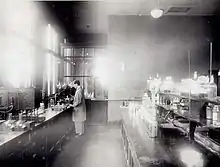
The activated sludge process was discovered in 1913 in the United Kingdom by two engineers, Edward Ardern and W.T. Lockett,[9] who were conducting research for the Manchester Corporation Rivers Department at Davyhulme Sewage Works. In 1912, Dr. Gilbert Fowler, a scientist at the University of Manchester, observed experiments being conducted at the Lawrence Experiment Station at Massachusetts involving the aeration of sewage in a bottle that had been coated with algae. Fowler's engineering colleagues, Ardern and Lockett,[9] experimented on treating sewage in a draw-and-fill reactor, which produced a highly treated effluent. They aerated the waste-water continuously for about a month and were able to achieve a complete nitrification of the sample material. Believing that the sludge had been activated (in a similar manner to activated carbon) the process was named activated sludge. Not until much later was it realized that what had actually occurred was a means to concentrate biological organisms, decoupling the liquid retention time (ideally, low, for a compact treatment system) from the solids retention time (ideally, fairly high, for an effluent low in BOD5 and ammonia.)
Their results were published in their seminal 1914 paper, and the first full-scale continuous-flow system was installed at Worcester two years later. In the aftermath of the First World War the new treatment method spread rapidly, especially to the USA, Denmark, Germany and Canada. By the late 1930s, the activated sludge treatment became a well-known biological wastewater treatment process in those countries where sewer systems and sewage treatment plants were common.[20]
See also
- Activated sludge model
- Aerated lagoon
- Aerobic granulation
- Aerobic granular reactor
- Aerobic treatment system
- Industrial wastewater treatment
- List of wastewater treatment technologies
- Membrane bioreactor
- Rotating biological contactor
- Sludge bulking
- Thermal hydrolysis
References
- "Activated Sludge Process". web.deu.edu.tr. Retrieved 2019-12-27.
- "Mark van Loosdrecht - Professor at Delft University of Technology". The Source. International Water Association. 2015-10-13.
- "First of three Nereda wastewater treatment plants in Ireland took flow". Dutch Water Sector. Partners for Water. 2015-09-10. Retrieved 2016-05-03.
- "Explaining the Activated Sludge Process" (PDF). University of Virginia - National small flows clearing house. 2003. Archived from the original (PDF) on 17 August 2012. Retrieved 6 February 2022.
- Oerther DB, de los Reyes FL, Hernandez M, Raskin L (1999). "Simultaneous oligonucleotide probe hybridization and immunostaining for in situ detection of Gordona species in activated sludge". FEMS Microbiology Ecology. 29 (2): 129–136. doi:10.1111/j.1574-6941.1999.tb00604.x.
- Wastewater engineering : treatment and reuse (4th ed.). Metcalf & Eddy, Inc., McGraw Hill, USA. 2003. p. 1456. ISBN 0-07-112250-8.
- "Lesson 7: Activated Sludge". Water/Wastewater Distance Learning. Mountain Empire Community College. 2013-03-19. Retrieved 2022-02-19.
- "Mathematics For Wastewater Operators" (PDF). Archived from the original on 2012-09-07.
{{cite web}}: CS1 maint: unfit URL (link) - Beychok, Milton R. (1967). Aqueous Wastes from Petroleum and Petrochemical Plants (1st ed.). John Wiley & Sons Ltd. LCCN 67019834.
- "Code of Practice, Flows and Loads-2, British Water". Archived from the original on 2009-03-26. Retrieved 2007-09-08.
- Review of UK and international standards Archived September 28, 2007, at the Wayback Machine
- British Standard BS 6297:1983
- EPA. Washington, DC (2000). "Package Plants." Wastewater Technology Fact Sheet. Document no. EPA 832-F-00-016.
- Vertical Shaft Projects
- Tilbury construction
- "NORAM VERTREAT™ (VERtical TREATment)". Archived from the original on 2015-07-03. Retrieved 2015-08-13.
- Beychok, M.R. (1971). "Performance of surface-aerated basins". Chemical Engineering Progress Symposium Series. 67 (107): 322–339. Available at CSA Illumina website Archived 2007-11-14 at the Wayback Machine
- Saikaly PE, Oerther DB (2011). "Diversity of dominant bacterial taxa in activated sludge promotes functional resistance following toxic shock loading". Microbial Ecology. 61 (3): 557–567. doi:10.1007/s00248-010-9783-6. PMID 21153808. S2CID 38062767.
- Von Sperling, M. (2015). "Wastewater Characteristics, Treatment and Disposal". Water Intelligence Online. 6: 9781780402086. doi:10.2166/9781780402086. ISSN 1476-1777.
- Benidickson, Jamie (2011). The Culture of Flushing: A Social and Legal History of Sewage. UBC Press. ISBN 9780774841382. Retrieved 2013-02-07.